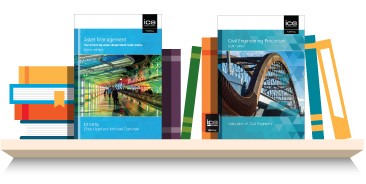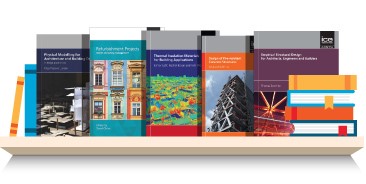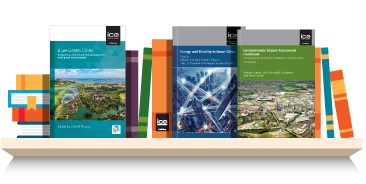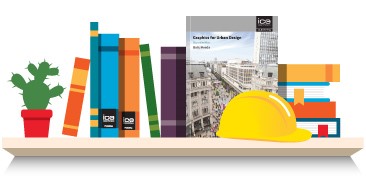Did you know that reading our books not only helps to grow your knowledge, but it also counts towards your CPD record? Check out our editors’ top picks.

- Updated: 02 Sep 2020
- Author: ICE Publishing editors, Melanie Bell, James Hobbs and Michael Fenton
Once you have become a qualified engineer with the ICE, it’s your duty to continue the professional development process of learning and expanding your skill set. Reading books related to civil engineering is a fun and easy way to engage in lifelong learning – and it counts towards your Continuing Professional Development (CPD) record! That’s right, reading will help you maintain your ICE membership and stay on top of your field.
If professional development is your goal, you can’t go wrong by picking out books from ICE Publishing. Below, we recommend carefully selected titles in four areas of civil engineering and the built environment. Whether you’re interested in educating yourself about management or smart cities, you’re bound to discover something new.
But first, here is a little background about each of us.
Melanie Bell, Development Editor
I work on each book’s manuscript, helping authors shape and develop the text. I also write a monthly blog for book authors. Prior to working at ICE Publishing, I edited defense and security content for RUSI, taught writing at the university level, and co-authored a popular psychology title, The Modern Enneagram.
James Hobbs, Commissioning Editor
I am a Commissioning Editor for ICE Publishing, covering the topics of bridges, construction materials, geotechnical and ground engineering, structures and buildings, urban design and planning and water, wastewater and maritime. Contact me with any suggestions for books or projects related to these topic areas.
Michael Fenton, Commissioning Editor
I am also a Commissioning Editor in the books department at ICE Publishing. I’m interested in hearing from prospective authors working in areas of contracts and law, project management, transportation, energy, engineering sustainability, and digital technologies in Civil Engineering.
Project management and people management

Melanie recommends:
Asset Management: The financial side of project management is one of its most important aspects, as without financing, no project can get off the ground or come to completion. This book tells you what you need to know about reducing costs and risks while increasing value for your project or business.
Michael recommends:
Civil Engineering Procedure: Now in its eighth edition, this book has been an essential companion for several generations of civil engineers. In clear and simple language, and a concise format, it provides a very useful guide to a broad range of project and contract management principles. I’ve met engineers at various career stages who’ve said they refer to it on a regular basis.
Structures and buildings

Melanie recommends:
Physical Modelling for Architecture and Building Design: This book introduces the role of physical models in design practice and how they have been affected by digital tools. It’s a useful contemporary read for anyone involved in building design.
Refurbishment Projects: Many professionals in the industry who focus on new structures are unfamiliar with the unique needs and demands of refurbishment projects. This book, focused on health and safety management, is a great place to learn how refurbishment differs from new builds.
James recommends:
Thermal Insulation Materials for Building Applications: This book details the often forgotten but vitally important use of thermal insulation materials in buildings. Any built environment professional should read this book to improve their understanding of the topic and make sure that they are using the right material in their building project be it for environmental, economic, safety or performance reasons.
Design of Fire-resistant Concrete Structures: Effective design and build of structures can mitigate the impact a fire can have on a building and this book guides you through the key aspects of effective design. It’s an essential read not just for understanding concrete types and characteristics but for need-to-know fire safety considerations.
Empirical Structural Design for Architects, Engineers and Builders provides an explanation of empirical design as a practical means of making preliminary structural design decisions. Written with the early career engineer in mind, the book will also be valuable to participants in the building construction process, including engineers.
Smart cities and sustainable infrastructure

Melanie recommends:
Blue-Green Cities: This innovative title investigates how cities can manage flood risk sustainably by using blue-green approaches. This combination of green spaces and drainage systems deliver multiple co-benefits for city-dwellers and the environment as well. Its big-picture view and excellent case studies from the Blue-Green Cities Research Project make it stand out from the pack.
Michael recommends:
Energy and Mobility in Smart Cities: This edited collection brings together a range of international perspectives and cutting-edge research on the theme of smart cities. It covers a range of fascinating topic areas like the development of autonomous vehicles, intelligent transport systems, and smart grids. It also includes interesting discussions of the broader trends which are shaping the development of smart cities.
Environmental Impact Assessment Handbook: This popular handbook gives a complete practical guide to the process of Environmental Impact Assessment. Written by four practitioners with extensive experience in this area, the book includes a wealth of practical advice and case studies which guide practitioners in the effective use of EIA in the planning process. The final chapter includes expert briefings across a range of topics including human health, biodiversity, soil, water, air quality and climate change.
Other

Melanie recommends:
BIM in Principle and in Practice: If you don’t already own this classic reference, even if you aren’t using BIM, pick yourself up a copy of the third edition. It makes for a thorough, up-to-date introduction to this digital way of working and its applications throughout the construction.
Graphics for Urban Design: This book brings together hand-rendered and digital graphic techniques for the urban design process. You’re sure to learn new visual techniques that you can apply to your own work, along with some fascinating case studies and history.
Hopefully this list has sparked inspiration for reading far and wide in your field. We wish you the best of luck on your professional development journey! If you have an idea for a book, don’t forget to contact us.
